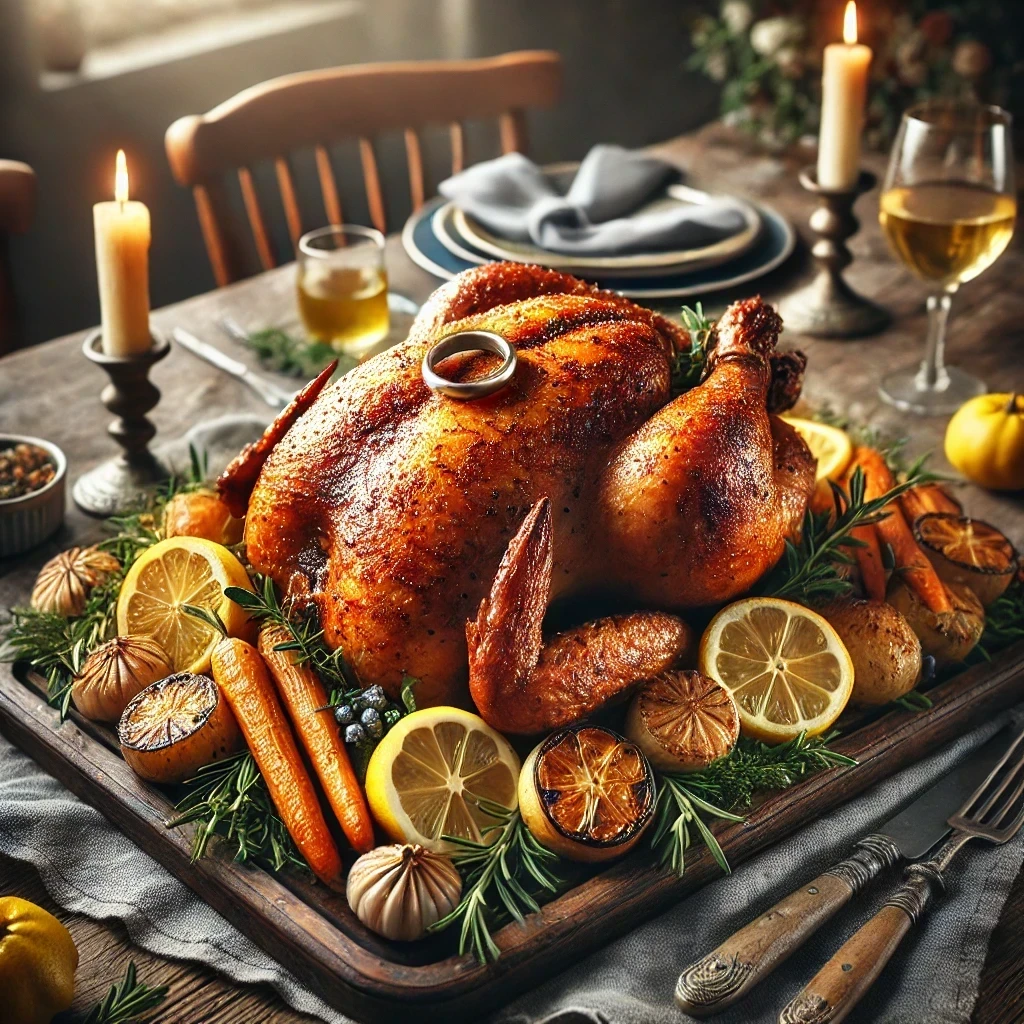Engagement Chicken is a delightful and flavorful roasted chicken dish known for its romantic origins and irresistible taste.
This recipe not only promises a tender and juicy chicken but also a heartwarming story that might just lead to a proposal! Let’s dive into the details and learn how to make this delicious dish.
Table of Contents
Ingredients
Serves: 4
- 1 whole chicken (about 4-5 pounds)
- 1/2 cup fresh lemon juice (about 2 large lemons)
- 1/4 cup olive oil
- 1 tablespoon kosher salt
- 1 tablespoon black pepper
- 2 teaspoons dried thyme
- 2 teaspoons dried rosemary
- 1 teaspoon garlic powder
- 1 teaspoon onion powder
- 2 lemons, halved
- 1 head of garlic, halved crosswise
- Fresh rosemary and thyme sprigs
- 1/2 cup chicken broth or white wine (optional)
Step-by-Step Instructions
Preparation
- Preheat the Oven: Preheat your oven to 400°F (200°C). Adjust the oven rack to the middle position.
- Prepare the Chicken: Remove the giblets from the chicken cavity if present. Rinse the chicken inside and out under cold water, then pat dry with paper towels.
Marinate the Chicken
- Make the Marinade: In a small bowl, combine the lemon juice, olive oil, kosher salt, black pepper, dried thyme, dried rosemary, garlic powder, and onion powder. Mix well.
- Season the Chicken: Place the chicken in a large roasting pan. Rub the marinade all over the chicken, making sure to get under the skin and inside the cavity for maximum flavor.
- Stuff the Chicken: Stuff the chicken cavity with the lemon halves, garlic halves, and a few sprigs of fresh rosemary and thyme.
Roast the Chicken
- Truss the Chicken: Tie the legs together with kitchen twine to ensure even cooking and to keep the stuffing inside.
- Add Broth/Wine: (Optional) Pour the chicken broth or white wine into the roasting pan around the chicken. This will help keep the chicken moist and add extra flavor.
- Roast the Chicken: Place the roasting pan in the preheated oven and roast for about 1 hour and 20 minutes, or until the internal temperature reaches 165°F (74°C) in the thickest part of the thigh.
- Baste Regularly: Baste the chicken every 20 minutes with the juices from the pan to keep it moist and flavorful.
- Rest the Chicken: Once done, remove the chicken from the oven and let it rest for 10-15 minutes before carving. This allows the juices to redistribute throughout the meat.
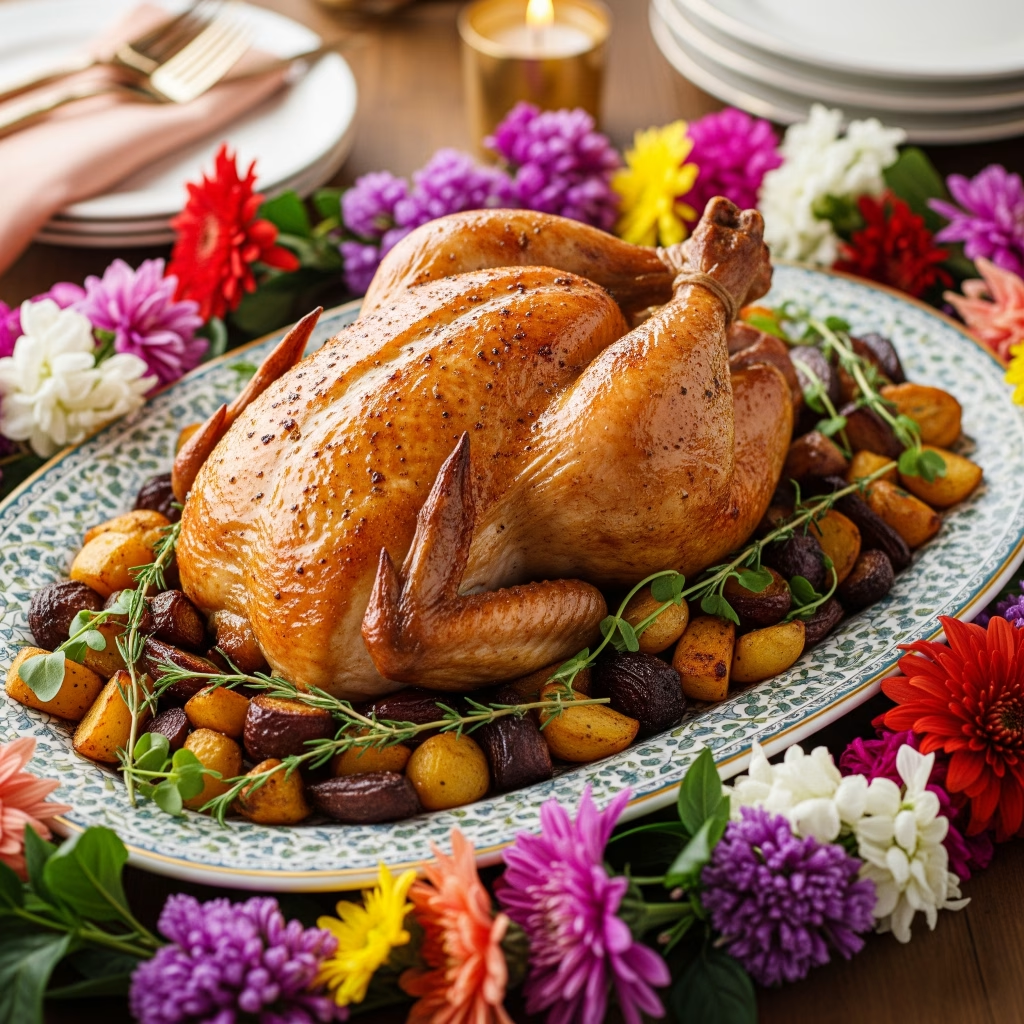
Serving Suggestions
- Carve the Chicken: Cut the chicken into serving pieces and arrange them on a platter.
- Serve with Juices: Drizzle the pan juices over the chicken for added flavor.
- Accompaniments: Serve with roasted vegetables, mashed potatoes, or a fresh green salad.
- Garnish: Garnish with fresh lemon slices and sprigs of rosemary or thyme for an elegant presentation.
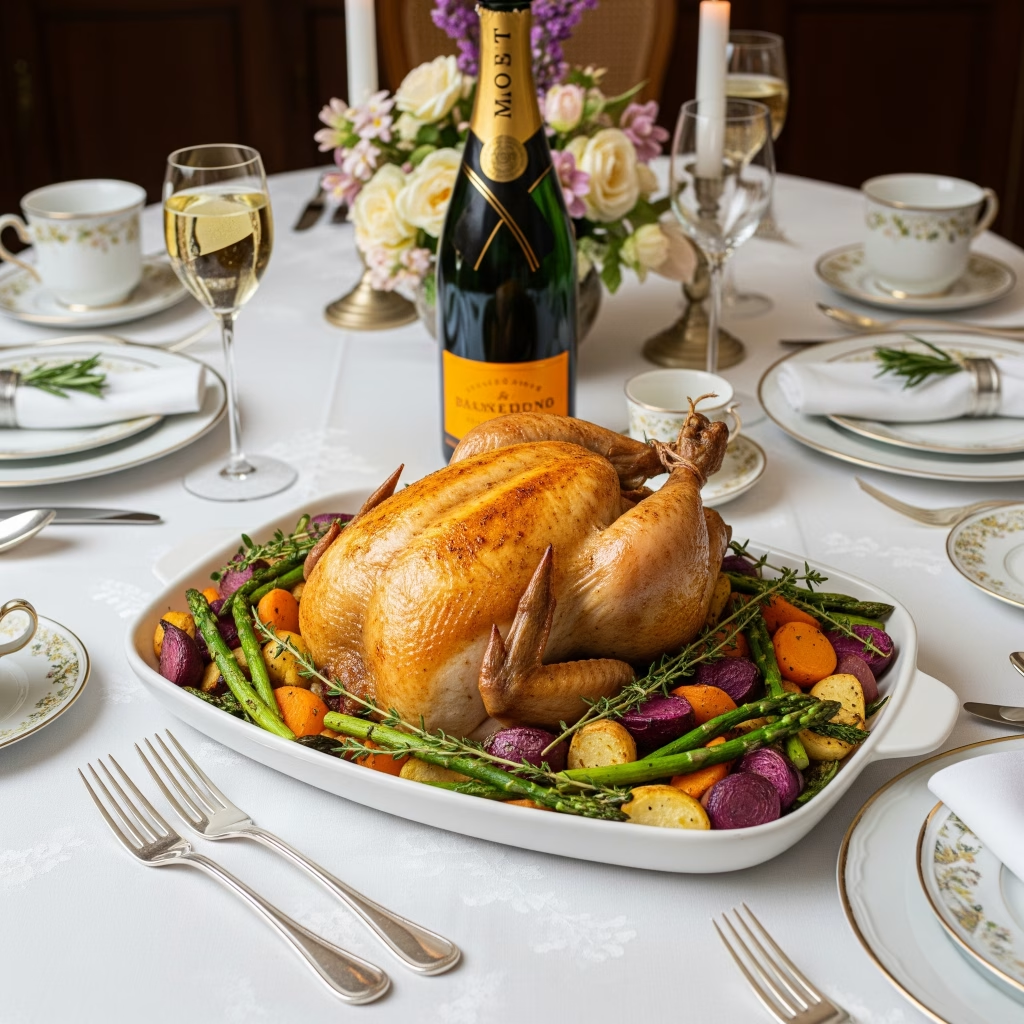
Tips for Perfect Engagement Chicken
- Pat Dry: Ensure the chicken is thoroughly dried before applying the marinade for a crispy skin.
- Room Temperature: Let the chicken come to room temperature before roasting to ensure even cooking.
- Proper Basting: Regular basting keeps the chicken moist and enhances the flavor.
- Use a Meat Thermometer: To avoid overcooking or undercooking, use a meat thermometer to check the internal temperature.
- Resting Time: Allowing the chicken to rest after roasting makes it juicier and easier to carve.
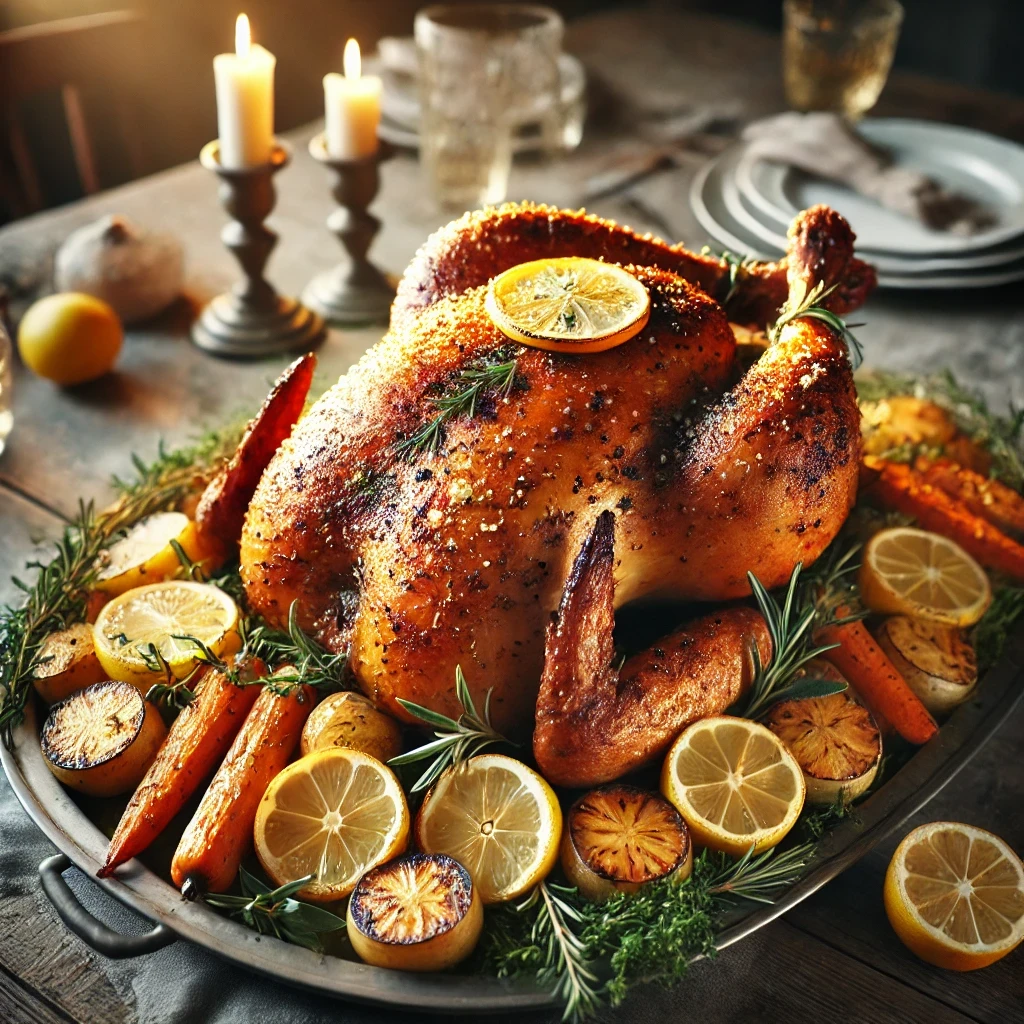
Healthier Alternatives
- Less Oil: Reduce the amount of olive oil used in the marinade to cut down on fat.
- Skinless Option: Remove the skin before marinating to reduce fat and calories.
- More Veggies: Add more vegetables like carrots, potatoes, and onions to the roasting pan for a balanced meal.
- Whole Grains: Serve with quinoa or brown rice instead of mashed potatoes for a healthier side dish.
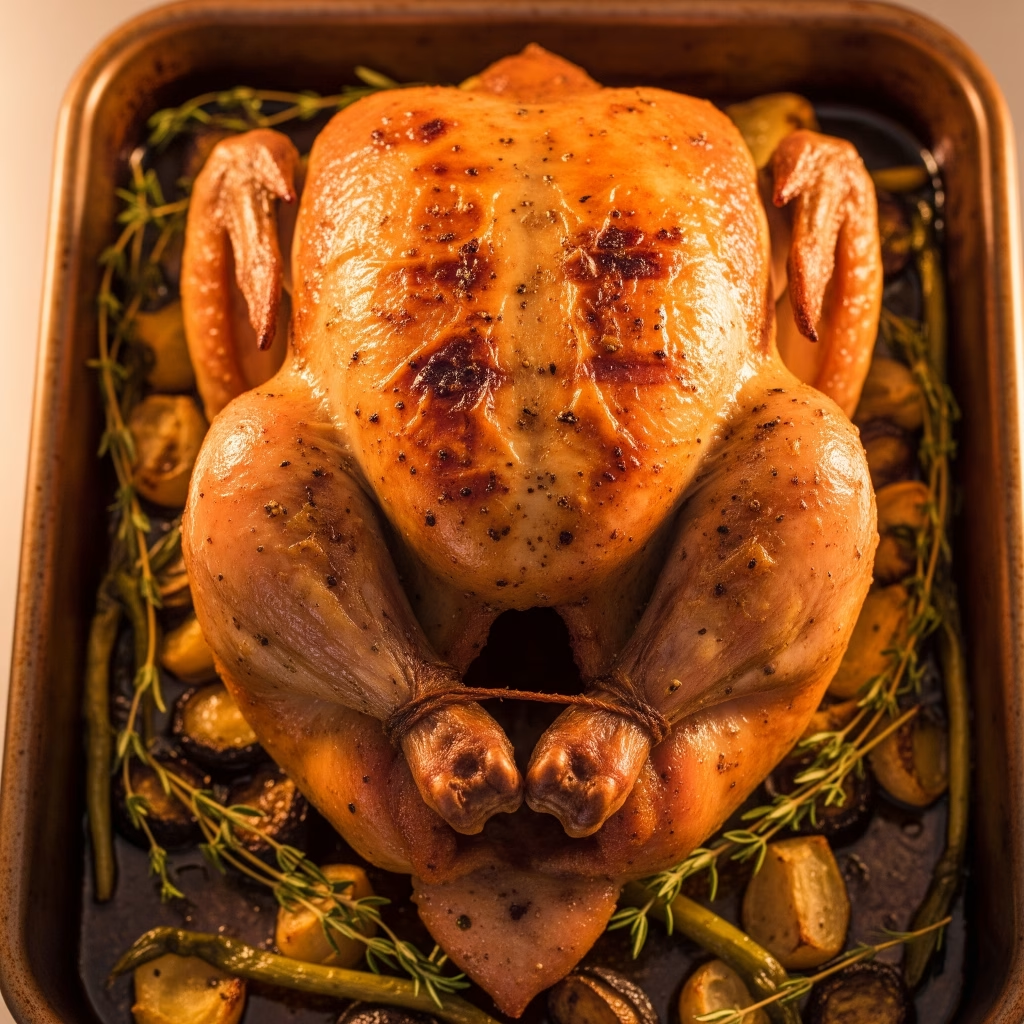
Creative Variations
- Spicy Engagement Chicken: Add 1-2 teaspoons of cayenne pepper or red pepper flakes to the marinade for a spicy kick.
- Herb-Infused Chicken: Experiment with different herbs like basil, oregano, or tarragon for unique flavors.
- Citrus Twist: Substitute lemons with oranges or limes for a different citrus flavor profile.
- Garlic Lover’s Chicken: Double the amount of garlic for a robust garlic flavor.
- Mediterranean Style: Add olives, capers, and sun-dried tomatoes to the roasting pan for a Mediterranean twist.
Common Mistakes to Avoid
- Overcrowding the Pan: Ensure there is enough space around the chicken for even roasting.
- Skipping the Basting: Regular basting is crucial for a moist and flavorful chicken.
- Not Trussing: Tying the legs together ensures even cooking and prevents the stuffing from falling out.
- Ignoring Resting Time: Cutting the chicken immediately after roasting can result in dry meat.
- Underseasoning: Be generous with seasoning to enhance the flavor of the chicken.
History of Engagement Chicken
The origin of Engagement Chicken is as delightful as the dish itself. It dates back to the early 1980s when a Glamour magazine editor shared a simple roasted chicken recipe with her assistant. The assistant, after cooking this dish for her boyfriend, was soon engaged. Word spread, and it became a tradition for women to cook this dish with hopes of receiving a proposal.
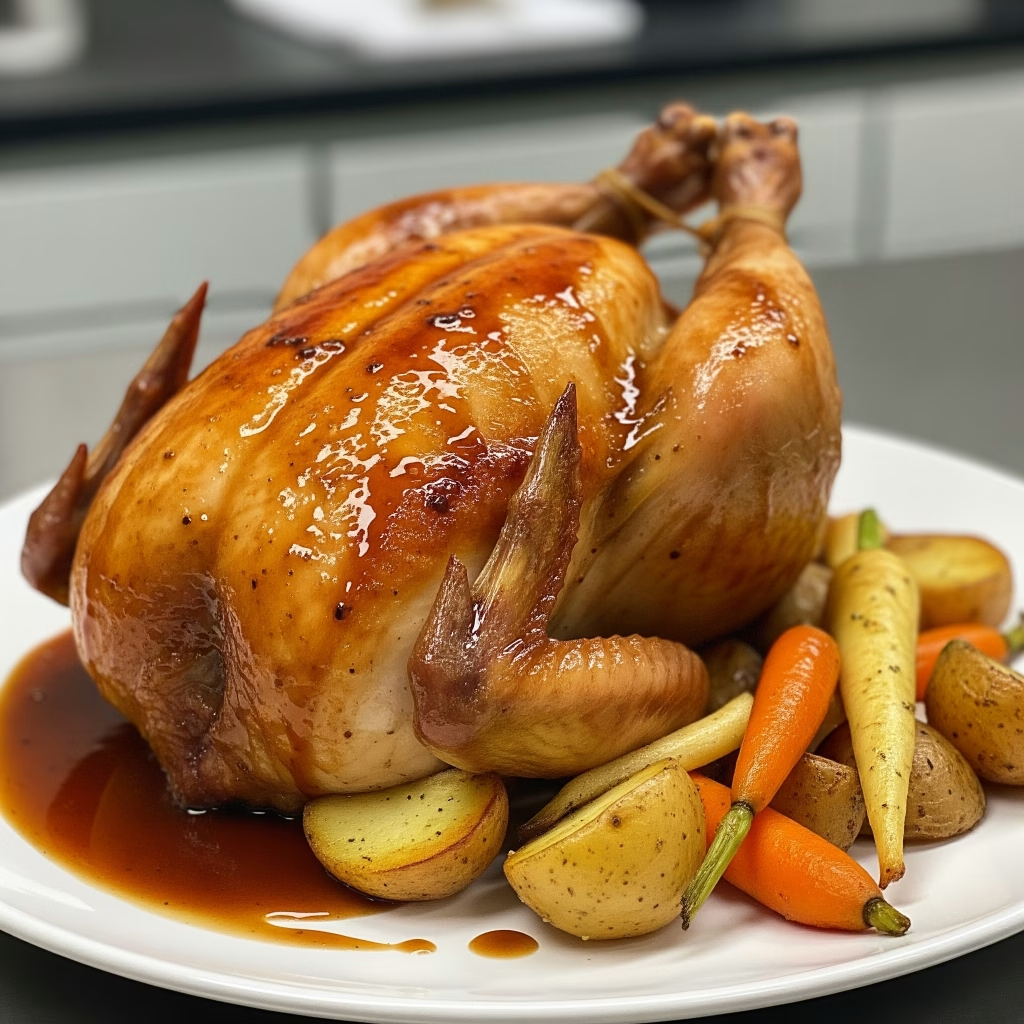
Romantic Roots
This recipe’s romantic connotations were further solidified when multiple Glamour employees experienced similar results. They cooked the chicken for their significant others, leading to engagements. The recipe became known as “Engagement Chicken,” symbolizing love, commitment, and the magic of a home-cooked meal.
Modern-Day Popularity
Today, Engagement Chicken remains a popular recipe for those looking to add a touch of romance to their culinary repertoire. It’s not just about the proposal; it’s about the effort, care, and love put into creating a meal that brings people together. Whether or not it leads to an engagement, it’s sure to impress and satisfy.
FAQs about Engagement Chicken
- What makes Engagement Chicken special? Engagement Chicken is renowned for its romantic origins and delicious flavor. It’s believed to be so tasty that it leads to marriage proposals!
- Can I use a different type of poultry? Yes, you can use other poultry like turkey or Cornish hens, but cooking times will vary.
- How do I know when the chicken is done? Use a meat thermometer. The internal temperature should reach 165°F (74°C) in the thickest part of the thigh.
- Can I marinate the chicken overnight? Yes, marinating the chicken overnight can enhance the flavors even more.
- What can I do with leftovers? Leftover chicken can be used in sandwiches, salads, soups, or casseroles.
- Do I have to use fresh herbs? Fresh herbs add a vibrant flavor, but dried herbs can be used as a substitute.
- Can I cook this chicken on a grill? Yes, you can grill the chicken, but make sure to use indirect heat and monitor the temperature closely.
- How do I prevent the chicken from drying out? Regular basting and letting the chicken rest after cooking help keep it moist.
- What should I do if the skin isn’t crispy enough? If the skin isn’t crispy, you can broil the chicken for a few minutes at the end of the cooking time.
- Is Engagement Chicken suitable for special diets? Engagement Chicken can be adapted for various diets by making substitutions such as using less oil or removing the skin.
Engagement Chicken is more than just a recipe; it’s a symbol of love, care, and tradition.
Whether you’re cooking it to impress a special someone or simply to enjoy a delicious meal with family and friends, this dish is sure to delight.
With its rich history, mouth-watering flavor, and numerous variations, Engagement Chicken will become a favorite in your culinary repertoire. Happy cooking!


